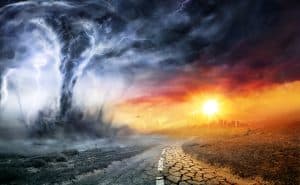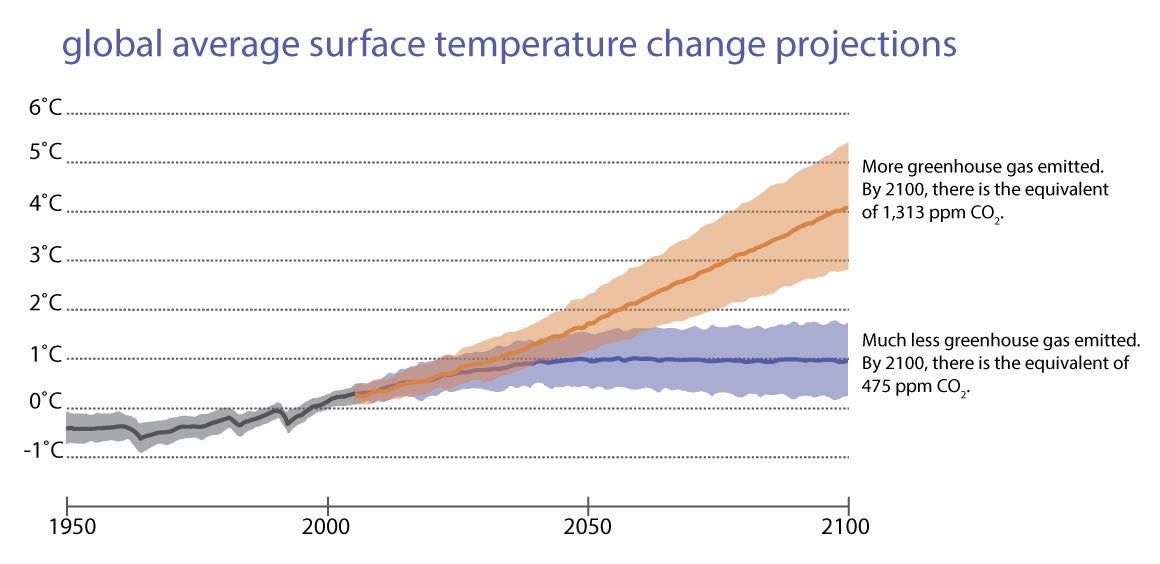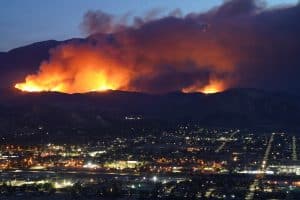What are the Major Changes in Global Climate?
 Climate change is adversely affecting all parts of the earth. There have been dramatic increases in greenhouse gas emissions (GHGs) globally since the industrial revolution of the 19th century.
Climate change is adversely affecting all parts of the earth. There have been dramatic increases in greenhouse gas emissions (GHGs) globally since the industrial revolution of the 19th century.
The planet warms faster as more GHGs are added to the earth's atmosphere.
The Intergovernmental Panel on Climate Change, expressing the global scientific consensus on the matter, warns that “global net human-caused emissions of carbon dioxide (CO2) need to fall by about 45% from 2010 levels by 2030, reaching 'net zero' around 2050. This means that any remaining emissions would need to be balanced by removing CO2 from the air...The decisions we make today are critical in ensuring a safe and sustainable world for everyone, both now and in the future.”
With GHGs (CO2, methane, nitrous oxide, and other gases - see epa.gov/ghgemissions/overview-greenhouse-gases) continually added to the earth's atmosphere, the planet continues to warm at an increasing rate.
Unfortunately, much larger changes to the earth's climate are projected despite the current pace of global climate change mitigation.
Thus, an increase in the pace of climate change mitigation (such as increased global investment in, and implementation of, clean and sustainable energy technologies - most notably - renewable energy) is imperative to slow the rate of climate change.
In this article, the focus is on just a few (of many) categories of climate change, all of which represent significant adverse impacts to people and ecosystems.
Adverse climate feedback loops will lead to 'tipping points' that might cause 'runaway climate change'. The way to avoid this scenario is for governments, industries, and the private sector throughout the world to increase investments exponentially in climate mitigation technologies.
Adverse Climate Feedback Loops
 As the planet's temperature rises, ocean temperature also rises in some regions globally, while simultaneously droughts and wildfires increase in other regions, and adverse climate feedback loops occur globally.
As the planet's temperature rises, ocean temperature also rises in some regions globally, while simultaneously droughts and wildfires increase in other regions, and adverse climate feedback loops occur globally.
For example, as the earth's temperature and ocean temperature rise, there is also an increase in the size and frequency of intense storms and flooding.
The increase in extreme storms leads again to an increase in the very factors that lead to more extreme wet weather in the first place (evidence of an increase in adverse climate feedback loops).
At the same time that extreme storms pummel some regions, global warming leads to severe drought in other parts of the planet, and severe wildfires result. The larger wildfires and drought dry out land and make way for more adverse climate feedback loops (higher average temperatures, more extreme drought, more extreme wildfires, etc...).
An increase in severe drought globally also has knock-on effects, such as devastation to agricultural food crops throughout entire regions of the planet.
"From the United Nations Food and Agricultural Organization: "The percentage of the planet affected by drought has more than doubled in the last 40 years and in the same timespan droughts have affected more people worldwide than any other natural hazard.
Climate change is indeed exacerbating drought in many parts of the world, increasing its frequency, severity and duration. Severe drought episodes have a dire impact on the socio-economic sector and the environment and can lead to massive famines and migration, natural resource degradation, and weak economic performance."
[QUOTE FROM - fao.org/land-water/droughtandag]
Atmospheric Changes/ Global Warming

Global warming presently is primarily due to human-caused GHGs from the combustion of fossil fuels.
Essentially, rises in GHGs will continue to increase average global temperatures at a continuously higher rate.
The impacts and pace of global warming simultaneously accelerate adverse feedback loops, which have the effect of increasing the pace of global temperature rise.
Thus, the hope to reduce the consequences of climate change is tied to the successful global effort to reduce GHGs - first and foremost, through the increased use of renewable energy on a global scale.
Consequences of global warming and related adverse climate feedback loops include increases in extreme weather events of all kinds, such as:
- increased severity of hurricanes, typhoons, and cyclones
- disruption of global weather patterns, such as jet stream disturbances that send colder weather further south (i.e. 'polar vortex')
- chaotic increases in rainfall and flooding in parts of the world, while simultaneously other parts of the world experience -
- drought, heatwaves, wildfires, and devastation to agriculture
- increases in toxic algal blooms; especially in freshwater ecosystems such as lakes, but also in coastal marine habitats
- extinction of wildlife species and ecosystems; degradation of wildlife habitats and biodiversity globally
Read more about global warming here
Arctic Warming/ Sea Level Rise
The consequences of melting glaciers and sea ice have worldwide implications including rising ocean water levels. Icebergs and other smaller ice formations throughout the sea are melting due to global warming, in addition to glaciers in Greenland, and throughout the world and Arctic.
Sea level rise is already threatening some regions of the planet, especially during extreme high tide and flooding events, and especially for low-lying communities on coasts and islands. Melting ice of all sizes, and warming oceans, adversely affects the lives of marine wildlife species and ecosystems. Read more about the adverse effects on marine wildlife from global warming below.
Adverse Marine Changes
 Changes to global ocean habitats are making life difficult for vast amounts of marine species. Fish and marine wildlife species' diversity ranges and distribution are changing significantly due to global warming. These adverse effects on marine species correspond to climate changes to the planet; rising sea levels due to melting glaciers & polar ice melt, and composition changes in oceans such as increasing ocean acidification.
Changes to global ocean habitats are making life difficult for vast amounts of marine species. Fish and marine wildlife species' diversity ranges and distribution are changing significantly due to global warming. These adverse effects on marine species correspond to climate changes to the planet; rising sea levels due to melting glaciers & polar ice melt, and composition changes in oceans such as increasing ocean acidification.
Ocean acidification has led to mass die-offs of coral reefs, home to a diverse set of marine species. Compounding adverse marine changes have affected coastal ecosystems, island-nations, and communities, causing them to face increasing exposure to storms, floods, as well as the aforementioned marine ecosystem issues.
All of these factors have led once-thriving marine ecosystems and coastal communities to be in a state of distress, struggling for survival.
Increase in Wildfires
 Wildfires are forecast to continue to increase in frequency, duration, and range. Increasing global temperatures will continue to increase the number and level of wildfires worldwide.
Wildfires are forecast to continue to increase in frequency, duration, and range. Increasing global temperatures will continue to increase the number and level of wildfires worldwide.
The increasing number of wildfires will, in turn, cause a continued increase in global temperatures. This is a diabolical adverse feedback loop of increased atmospheric GHGs and adverse effects of global warming; a continuous cycle of global environmental devastation.
Despite the seemingly unusually high frequency of wildfires that took place recently, it is alarming that there are many more large wildfires predicted over the coming couple of years.
In California and Australia, as well as throughout the entire planet; warmer temperatures, drier land conditions, and extreme dry gusty winds are expected to expand the length and increase the intensity of wildfires.
Thawing Permafrost
Thawing permafrost will release large amounts of potent GHGs, such as methane, increasing global warming. Thawing ground (for example, in Siberia) is also likely to disrupt municipal building sectors and other infrastructure on a regional basis; for regions where human activity and permafrost are both present.
The recent Arctic fires are an example of an adverse climate feedback loop; the fires set loose significantly high amounts of the potent GHG methane that had been locked in permafrost; increasing global warming and the potential for more severe Arctic fires.
GHGs continue to increase on a global basis, accelerating global warming. However, concerned people, countries, and cities, can help limit the effects of climate change, as seen in the cases of Green City Times' featured sustainable cities.
Please also see:
GCT's Plan to Reduce Greenhouse Gas Emissions
See Also: climate.nasa.gov/effects

